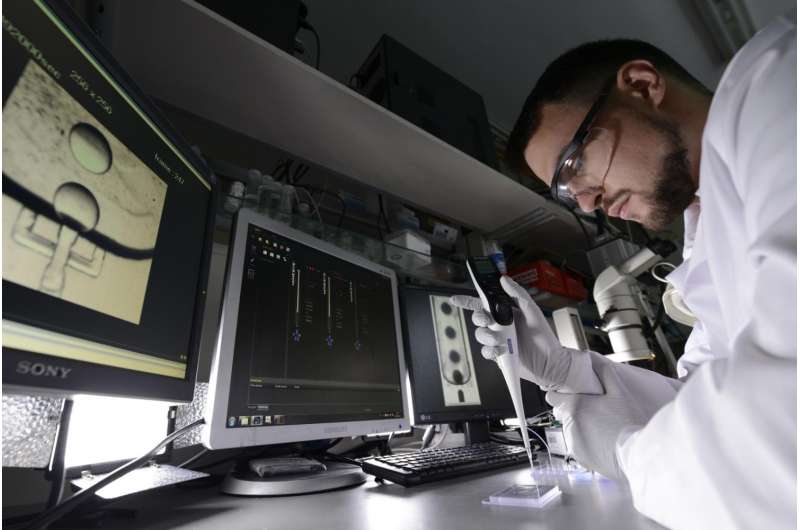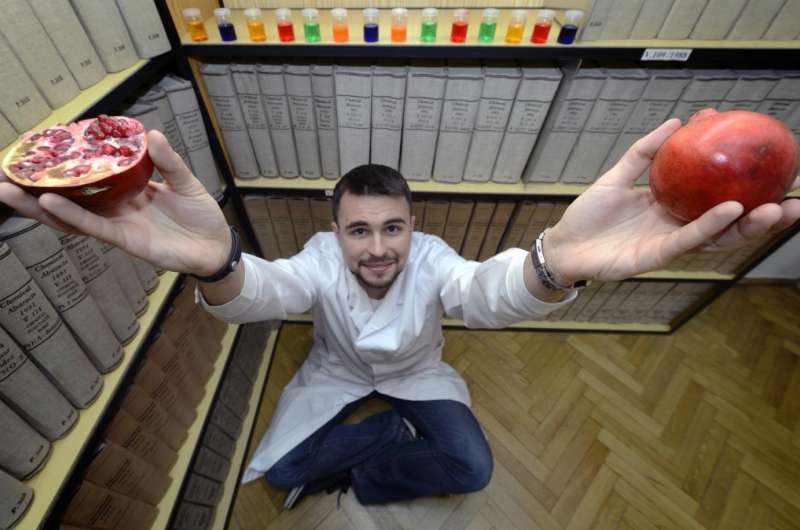Breakthrough device creates identical nanodroplets for research and sample archiving

A single drop with the volume of a millionth of a litre is really not very large and certainly does not look like something you can do much with. However, a simple device, constructed at the Institute of Physical Chemistry of the Polish Academy of Sciences in Warsaw, can split the microdroplet into a collection of equally-sized nanodroplets. Now, the chemicals or genetic material contained in a single microdroplet can be the starting point of even hundreds of experiments—or they can be archived in the form of nanodroplet libraries.
Until now, droplets produced by electronic pipettes or in sophisticated microfluidic devices differed in volume by significant percentages. Researchers at the Institute of Physical Chemistry of the Polish Academy of Sciences (IPC PAS) in Warsaw have developed a device that eliminates inaccuracies and produces droplets of virtually identical volume. In addition, they are calculated in nanolitres (billionth parts of a litre). Interestingly, the device is so simple that it can be used, for example, as the tip on a pipette. Its construction is an important step in the development of microfluidic systems, which are set to revolutionize chemistry just as integrated circuits did with electronics.
"In modern microfluidics, droplets are produced by apparatus either more or less complex, in processes carefully controlled by computers. We decided to use physics to control of the formation of droplets. However you look at it, physics still has several billion years more experience than we do in this field, doesn't it?" says Prof. Piotr Garstecki (IPC PAS).
Microfluidic systems are usually constructed by permanently sticking together two plates of transparent plastic (polycarbonate); one is covered with a network of thin grooves on the inner side. After the plates are joined, these grooves form channels into which a carrier liquid (usually oil) can be forced. By introducing a second liquid that is immiscible with the liquid carrier (e.g., water) into the system, droplets can be produced, transported, split, combined and their contents mixed.

"The Holy Grail of microfluidics is to create a laboratory of a size similar to modern integrated circuits capable of carrying out complex chemical and biological experiments. In other words, a lab on a chip. This is the goal, because at the moment what we have is a 'chip in a lab,'" says Dr. Filip Dutka (IPC PAS; Faculty of Physics, University of Warsaw) adding, "Current microfluidic systems can already do a lot. Their dimensions are small, but for such a plate to work, it has to be surrounded by syringe pumps, computers controlling flow, all in a tangle of tubes. Our device eliminates a large part of this cumbersome and expensive infrastructure."
The device, designed at the IPC PAS, commissioned by Curiosity Diagnostics, is a channel with a carefully designed geometry. When the sample fluid is introduced, it passes through an outlet configured in such a way that when the right amount of liquid has passed through it, surface tension forces naturally close the surface. As a result, each nanodroplet breaking off the outlet always has the same volume. Using different copies of the new instrument, Prof. Garstecki's group has produced series of droplets with sizes of from ca. 0.5 to ca. 50 nanolitres.
"Our device creates nanodroplets at a rate of several dozen per second, which is slightly slower than with traditional, controlled techniques. The number of droplets is smaller, but their quality has increased. Tests have shown that the size of the nanodroplets does not depend on the flow rate or viscosity of the sample liquid, and a given version of the device always generates droplets of the same size. In terms of even a ten-fold difference in flow velocity, the volumes of the droplets differ from each other by only a few percent. This means that the user has complete freedom in the implementation of the experiment, and the result is always exactly in compliance with the designed protocol," says Ph.D. student Adam Opalski, a biotechnologist from the IPC PAS.
The device developed at the IPC PAS has no moving parts, does not wear out and does not require power. Used in microfluidic systems, it will significantly reduce the need for accompanying infrastructure, which should accelerate the dissemination of microfluidic equipment. In a few years, the device could be widely available in the form of tips for a pipette.
Splitting even small amounts of liquid into nanodroplets opens up new research perspectives. Instead of one experiment on a microdroplet, it will now be possible to carry out several measurements in hundreds of separate experiments. The accuracy of statistical analysis will increase, and consequently, the certainty of the results of laboratory and diagnostic tests. A particularly interesting field of application is related to the fact that the nanodroplets suspended in the liquid carrier do not have the tendency to merge. Using the microfluidic device from the IPC PAS, the creation of a permanent and easy-to-store library of nanodroplets, numbering hundreds and thousands of droplets with valuable chemical or biological substances, becomes a matter of dipping an electronic pipette with the appropriate tip in oil, press the button—and waiting.
More information: Filip Dutka et al, Nano-liter droplet libraries from a pipette: step emulsificator that stabilizes droplet volume against variation in flow rate, Lab Chip (2016). DOI: 10.1039/c6lc00265j
Provided by Polish Academy of Sciences



















